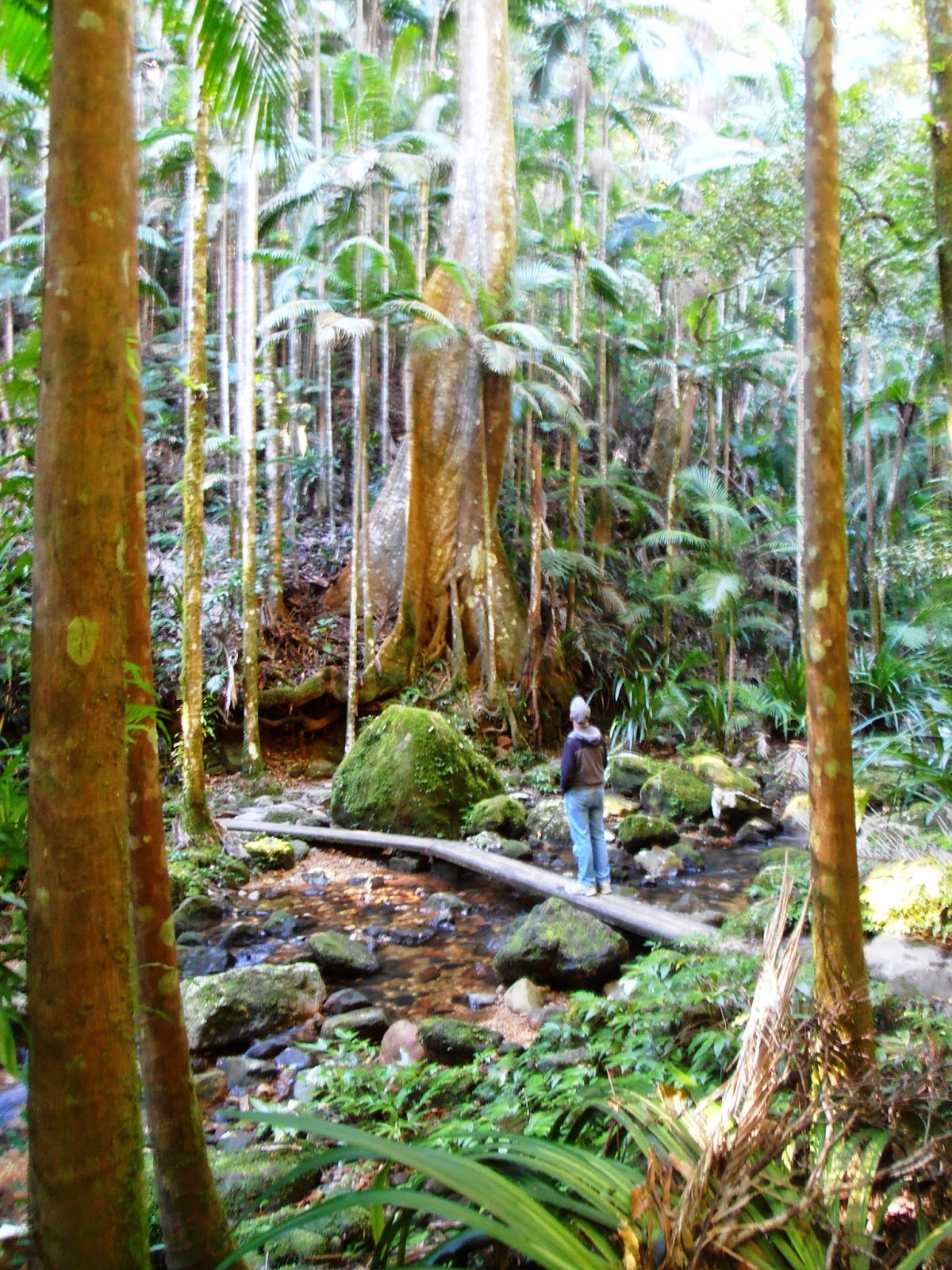The
decision was made over the cornflakes, muesli and coffee, that we would move on
and toward Murwillumbah to visit the art gallery, Tweed Heads and maybe over
the border into Queensland. Soon after 9 am we were wandering about the streets
of Mullumbimby, checking out the shops and those out and about. We had read
that this town had undergone a transformation from a supplier of agricultural
supplies to one echoing the buzzing of Byron Bay just down the road. Here it
wasn’t the back packers but the colourfully dressed rasta-locked young who
populate the cafes, the shops and the pavements. Here the young think nothing
of squatting against the shop fronts chatting companionably with others of
their kind; reminiscent of the ni-Vanuatu along the Port Vila waterfront. We
picked up our daily newspaper then returned to the rig parked a few blocks distant.
Then we set off northwards along the Coolamon Scenic Drive, a route not even in
our Tomtom’s databank; he repeated the “Turn around when possible!” command
until we turned him off. We pressed on along the narrow winding sealed road, an
alternative route back toward the Pacific Highway, through and over potholes,
and dodging the oncoming cars and the overgrowth on the road side, through very
beautiful scenery when we dared to take our eyes from the road immediately in
front. Co-driving is as demanding as being behind the wheel.
When
we did come down from the hills and emerge out of the bush, we were directed by
our forgiven navigator along the Brunswick Highway and then the Tweed Valley Way,
avoiding the freeway completely. We passed over the Burringbar Range, over some
of the road we had been driven by Clarry way back in February last year, just
as impressive now as then. Finally we came down toward Murwillumbah, to the
Tweed River Art Gallery just three kilometres from the centre of town. Before
leaving Mullumbimby, we had pulled out a couple of our travel books to check if
there was any reference to opening times; there was none. So you can imagine
our displeasure, to say the very least, when we discovered that the gallery was
closed on Mondays and Tuesdays. We drove on down to the Information Centre and
voiced our disappointment, engaging in lengthy conversation with a delightful man
who once sold and serviced caravans. He drew our attention to the artist and
his work in progress there in the Centre, a 360 degree view of the caldera from
Mount Warning. It is a huge undertaking and the amount of work already
completed is incredible. Completion date is November 2012; the pressure to complete
in time probably accounts for the taciturn nature of the artist.
Barry
directed us downstairs to where there is a wonderful collection of artwork, all
part of a competition that was held recently. Much of it is for sale and had we
had a wall large enough, I might have been tempted to suggest to Chris we
purchase a magnificent painting of the root system of a gigantic fig tree.
Lucky for him, and probably for me, there is no such space in our compact
caravan.
As
we came away, I did feel that we had not entirely wasted our time by travelling
north via Murwillumbah, the road thus far, and that eastwards back to the Pacific
Highway along the Tweed River is absolutely lovely, and today was the best of
days to enjoy such scenery. It had been cold on rising, at perhaps about six
degrees, however the sun soon warmed the day up and I was later envious of
those wearing sandals.
We
stopped at Stott’s Nature Reserve where we had camped one night last year, and
found it as muddy as it had been then. It served as a quiet spot to have lunch
and decide on our next move; to find a camp at Tweed Heads and collect mail.
The
former proved more difficult and we had been warned, but we prefer to travel
with a certain level of spontaneity, something that precludes booking ahead.
Our first choice of camp was full, the second right next door equally so. We
were directed to the council camp back along the river which is large and has
250 powered sites, and so here we are. It is a lovely camp and despite the huge
number of sites, is nearly full. The sooner the weather allows for free roadside
camping again the better however that depends on when we are willing to forgo
the use of an electric heater in the evenings.
Tweed
Heads with a population of about 52,000 is the most northern town in New South
Wales, set at the mouth of the Tweed River just across the border from its twin
town of Coolangatta. There are a couple of “main” post offices here in Tweed
Heads, and as Murphy’s Law would have it, our mail was at the second one we
called at, but it was there, and if you have followed this lengthy saga of
ours, you will realise that this is worth celebrating.
We
wandered about the shopping centre, checked out the ice-cream at MacDonald’s and
then drove up to Point Danger overlooking the river mouth to the south, and up
the coast to the high-rises of the Gold Coast silhouetted to the north east, in
doing so crossing the border a couple of times, before returning to our camp
back in New South Wales.








